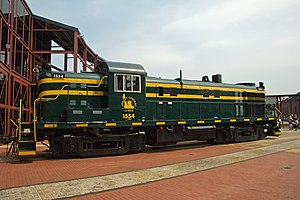The ALCO RS-3 is a 1,600 hp (1.2 MW), B-B diesel-electric locomotive manufactured from May 1950 to August 1956 by American Locomotive Company (ALCO) and its subsidiary Montreal Locomotive Works (MLW). A total of 1,418 were produced: 1,265 for American railroads, 98 for Canadian railroads, 48 for Brazilian railroads, and seven for Mexican railroads.
Quick Facts Type and origin, Power type ...
| ALCO RS-3 |
|---|
 |
|
|
| Performance figures |
|---|
| Maximum speed | 65–85 mph (105–137 km/h) |
|---|
| Power output | 1,600 hp (1.2 MW) |
|---|
| Tractive effort | 61,775 lb (28,021 kg) |
|---|
|
|
Close
The RS-3 greatly resembled the RS-1 and RS-2,[1][2] but it had 100 more horsepower thanks to its 12-cylinder, 1,600 hp ALCO Model 244 engine. It also had some changes to the fuel system and body shape.[3]
Much like the RS-1, many RS-3s served for decades; some are still in use as of 2022.
ALCO built the RS-3 to compete with EMD, Fairbanks-Morse, and Baldwin Locomotive Works—and in particular with EMD's GP7, introduced in 1949.
The arrival of the 1,500-hp GP7 led ALCO, Fairbanks-Morse, and Baldwin to increased the power of an existing locomotive line from 1,500 to 1,600 hp (1.1 to 1.2 MW) and add more improvements to create new locomotive lines. In 1950, Fairbanks-Morse introduced the 1,600 hp (1.2 MW) H-16-44, while Baldwin introduced the 1,600 hp (1.2 MW) Baldwin AS-16. ALCO's 1,500 hp (1.1 MW) line was the RS-2, although 31 were built in 1950 with 1,600 hp (1.2 MW). Fairbanks-Morse's 1,500 hp (1.1 MW) line was the H-15-44. Baldwin's 1,500 hp (1.1 MW) line was the Baldwin DRS-4-4-1500. EMD kept its GP7 at 1,500 hp (1.1 MW) until 1954, when it introduced the GP9, rated at 1,750 hp (1.30 MW).
In the end, EMD won the road switcher production race. EMD produced 2,729 GP7s. ALCO produced 377 RS-2s, and 1,418 RS-3s. Fairbanks-Morse produced 30 H-15-44s, and 296 H-16-44s. Baldwin produced 32 DRS-4-4-15s, and 127 AS-16s.
